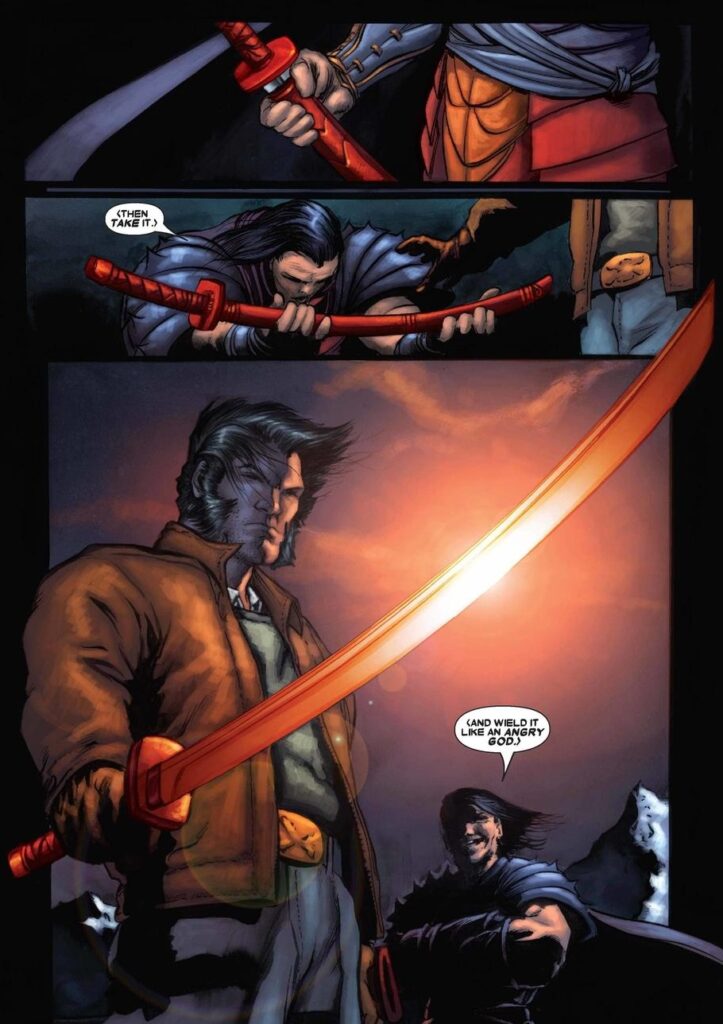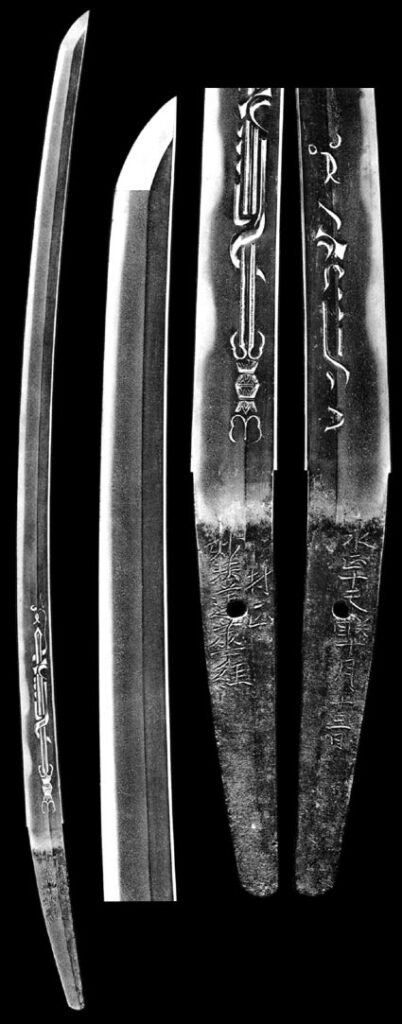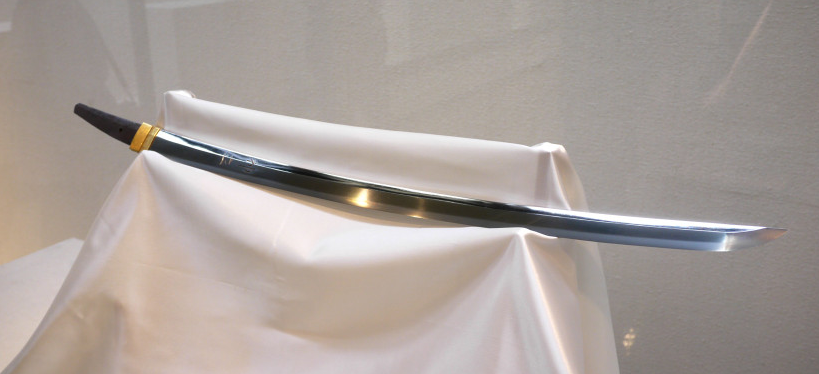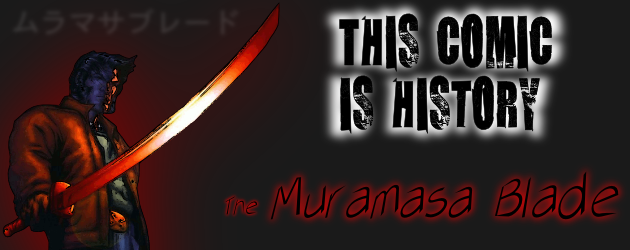For this edition of This Comic Is History, we’re going to be looking at an object, the Muramasa Blade. This is a sword with special properties that is said to be able to slice through just about anything in the Marvel Universe. However, this weapon was not cooked up by a modern comic writer, it is centuries old. In fact, real life Muramasa swords were in use by actual Samurai warriors several hundred years ago in Japan.
Muramasa Blades as they exist in the Marvel Universe
There exist two Muramasa Blades in the Marvel Universe. Both have at one time been in the possession of Wolverine. Both were forged by a Japanese swordsmith named Muramasa, which is where they get their name. One is black in color, and has been referred to as the Black Blade. The other is the newer of the two, which was originally red, but is currently the color of a traditional blade. Both swords are forged from an unknown, and virtually indestructible alloy.

The older of the two swords, the Black Blade, was made by Muramasa centuries ago. He crafted it with a part of his own “soul”, imbuing it with qualities unlike those possessed by any other sword.
Muramasa was said to be evil, and mad, and it’s these two qualities that are supposed to reside in the sword. Those who use Muramasa’s Black Blade gain increased strength as well as a heightened resistance to injury. They also gain Muramasa’s evil madness if they wield it for too long. This is something that Wolverine almost succumbed to while in possession of this sword. He came close to killing the Silver Samurai with it, but he overcame the sword’s influence and stopped himself before doing the deed. After this incident, the Black Blade came to be in the possession of the Silver Samurai. This took place back in 1988, in the pages of the first few issues of Wovlerine’s second series.
Showing its strength, this Black Blade has withstood attacks from Wolverine’s claws, as well as blows to his Adamantium laced bones without suffering any damage. Truly, this is a most dangerous weapon, especially in the hands of someone who might not fight against its evil influence. Bad news for anyone the Silver Samurai decides to introduce to Muramasa’s blade.

The second Muramasa Blade is the one that we’ve seen in action more recently. It was made for Wolverine by Muramasa, but it’s a little different from his original blade. This time Muramasa used a piece of Wolverine’s “soul” to forge this sword. Again, using an unknown and virtually indestructible metal alloy.
This one may prove to be more dangerous as well. It has been shown, much like the first Muramasa Blade, to be able to cut through just about anything. For instance, Wolverine used it on a S.H.I.V.A. robot, slicing it in half with a single blow. Upon later examination of the robot’s remains, scientists concluded that it hadn’t been merely cut in half, but that it had been sliced on a molecular level. Now that is sharp!
Another quality that this second Muramasa Blade possesses is the ability to retard a superhuman healing factor. Wolverine himself has been cut with this sword, and the wound did not heal for several days. He has also used it on Sabretooth, and ended his life in a rather gruesome fashion.
At one point, Wolverine gave his Blade to Cyclops for… safe keeping. Wolverine knew that if the time came to use it, Scott wouldn’t hesitate to do what needed to be done.
It’s the only thing that can kill me and make sure I stay dead.
–Wolverine
Yeah, this is one bad piece of metal.
However, this is the fictional Muramasa Blade. Did the real swords crafted by a swordsmith named Muramasa have such deadly potential, beyond what a conventional katana (samurai sword) could do?
The Real Muramasa Blades

Muramasa Sengo was a highly skilled swordsmith of 16th century Japan. This was the time of the Samurai warrior. A time when men fought for feudal lords, wielding death in the form of cold, folded steel. Muramasa has been described as a highly skilled swordsmith, as well as violent, and quite possibly on the brink of madness.
It’s those qualities, a lust for violence and madness, that he supposedly passed into his blades. There are plenty of legends surrounding not only Muramasa’s blades, but several swordsmiths of that time. One of the more sinister concerning Muramasa’s blades has to do with its influence on those who dared to use it. It was said that once drawn, a Muramasa blade had to taste blood before being put back into its scabbard (sheath). This went so far as to imply that it would get blood, even if it was that of its user, using its evil influence to urge a man to inflict a blow, even a fatal one, on himself. This perceived ability of the swords to produce a bloodlust within those who used them added to the deadly reputation that these supremely sharp blades already had. Now, decide for yourself how much stock you want to put in these legends. However, regardless of the legends, there were many who lost their lives at the edge of a Muramasa blade.
It is said that when a new ruler came to power in 1603, he forbade his samurai to wear katana made by Muramasa. This was due to the fact that many of his friends and relatives had been killed with Muramasa’s weapons. This new ruler had even injured himself with a Muramasa blade. This served to add to the legend and intrigue surrounding these swords.
Another legend that I found to be interesting is that of a comparison between a sword of Muramasa’s and that of another sword maker, Masamune. It is said that a Muramasa blade was placed upright in a flowing stream, and when leaves came in contact with its blade they were simply cut in two. Impressive indeed! However, when a Masamune blade was given the same treatment, the leaves flowed neatly around its edge. This made people believe that the Masamune blade possessed mystical properties, and it was deemed the superior blade. Either way, Muramasa’s blades were among the best of the best, and were famous for their sharpness. The work of these two men, who lived at different time periods, would be compared down till the present day.
Muramasa founded a school, teaching this most respected art form to others, as had been done for centuries in Japan. While he’s not regarded as the clear master of the art of sword making, there can be no doubting that he is among the very best there ever was.
The Sword Making

These swords were made from steel, but they weren’t just hammered out by any old guy with an anvil. There were tricks to getting the steel just right. If they used a steel that was too hard, the sword would retain a sharper edge for a longer period of time. The downside is that it would be too brittle, not having enough bend in it. Yes, swords needed to be able to flex so that they wouldn’t break during battle. This problem was solved by using a softer steel, although now the blades wouldn’t keep their sharp edge. Both methods proved inferior to what eventually solved these problems… folded steel.
This method uses a mix of both a hard and a softer steel, combining the two to deliver the best of both. The folding is where it gets interesting. A mixture of soft and hard steel would be stacked together like a sandwich, and then folded over onto itself, hammered out, then folded again. Some would be folded as many as 20 times. This process produced a blade with more than a million laminations! Yes, a million. This was taking place in Japan as early as the 13th century. Europe didn’t see steel of this quality until the 19th century. This process could take weeks, but the reward was a sword that could hold its sharp edge through several battles.
The sharpness of these swords is evidenced by the way they were tested. They were used on criminals to prove their performance on a human body. There were several swords that passed this test by slicing cleanly through 2 or even 3 human bodies at once. There are even tales of swords that cut through 5 bodies, with one swing. Flesh, muscle, bone, none of it mattered to these ridiculously deadly weapons. If this weren’t bad enough for their enemies, it gets worse. An art form sprang up within the samurai, that of killing an opponent with one swift strike of the sword. The challenge was to pull their sword from its sheath, and in that same motion, strike a killing blow, and then return the sword to its place just as quickly. Sounds like a super fast, split second, ballet of death. At least it was clean and fast.
Yes, they are deadly, and dangerous weapons. There is however, an artistry, a craftsmanship, that I can’t help but admire. Some collect firearms for such reasons, out of admiration for the quality of their construction. Fine swords from Japan’s past are rightfully kept in museums today, with some being listed among Japan’s national treasures. They no doubt helped forge Japanese culture and civilization so many years ago.
The swords, their makers, and the warriors who made their living with them continue to inspire us today. Stories like that of the Muramasa Blade in the Marvel Universe give us a glimpse into that centuries’ old world. The work of many writers in comics today show an interest the samurai. For example, Frank Miller has made it known both in interviews, and in his work that he is intrigued by the Japanese culture of so long ago. Its no wonder that the work of Muramasa has ended up in the comics we read, he truly is a legendary figure.

So, the next time you see the Muramasa Blade in a comic, you’ll know that there really was a man named Muramasa, and his swords were used to acquire land, power, respect and honor in medieval Japan.
Eli Anthony
eli@comicattack.net


Great write up Eli! I first heard of the blade way back in high school while writing a paper on Samurai culture and from then on I just kept reading up on whatever I could find about the Muramasa Blade and Samurai life as a whole. Plus the katana is one of my favorite weapons to use!
The blade is actually mentioned and the focus in several chapters of the Crying Freeman manga and anime along with a slew of other stories that I’ve read over the years
If you have never seen a sword master deliver a killing strike from his sheathed blade then I suggest you do and don’t blink man.
Cool history Eli! I’m kind of torn about it. On one hand I like it that there is something that can kill Logan. On the other hand though, if it ever does kill him, will he just be ressurected by some magical means anyway? lol -I’m still not sure how I feel about Daken in the long run as well.
Pingback: This Comic Is History: The Muramasa Blade | Cold Steel Knife
@InfiniteSpeech – I really like Samurai culture as well, its way cool stuff.
@Billy – Yeah, I think its cutting abilities are cool, but I don’t wanna see it anywhere near Wolverine. Daken on the other hand, I don’t know that I’d be too consternated to see him have a run in with it.
Fantastic story here Eli. I had no clue that the Muramasa Blade had some real history to it.
It’s an interesting concept that the real blades had to “taste blood” before being sheathed; this is something Frank Hebert borrowed in “Dune” with crysknives. If drawn, they couldn’t be sheathed until they made someone bleed.
Pingback: uberVU - social comments
Pingback: Top Cow Reviews: Broken Trinity: Pandora’s Box #1
Pingback: Marvel Snapshot: Character Spotlight: Daken
Pingback: DC Reviews: Green Lantern Corps #48
Pingback: Chirpin’ Tuesday Reviews 5/26/2010
Pingback: The Uncanny X-Piles I
Off-topic, perhaps, but I became fascinated with Japanese swords and sword-fighting in general, and Masamune and Muramasa weapons in particular while reading “The 47th Samurai” by Stephen Hunter [from the Bob Lee Swagger series]. An expert I am not, but Hunter obviously did his homework. He goes into excruciating detail about swords, sword-fighting, sword types, the whole nine yards. Things I have read since then have generally supported his fiction, and I probably liked it better than any of his other works. It also gives the reader an in-depth understanding of how gaijin are really viewed the the Japanese in general.
Pingback: The All-New Uncanny X-Piles #193 – ComicAttack.net
Pingback: Ye Olde School Cafe': Wolverine Classic Vol. 1, pt 1 – ComicAttack.net